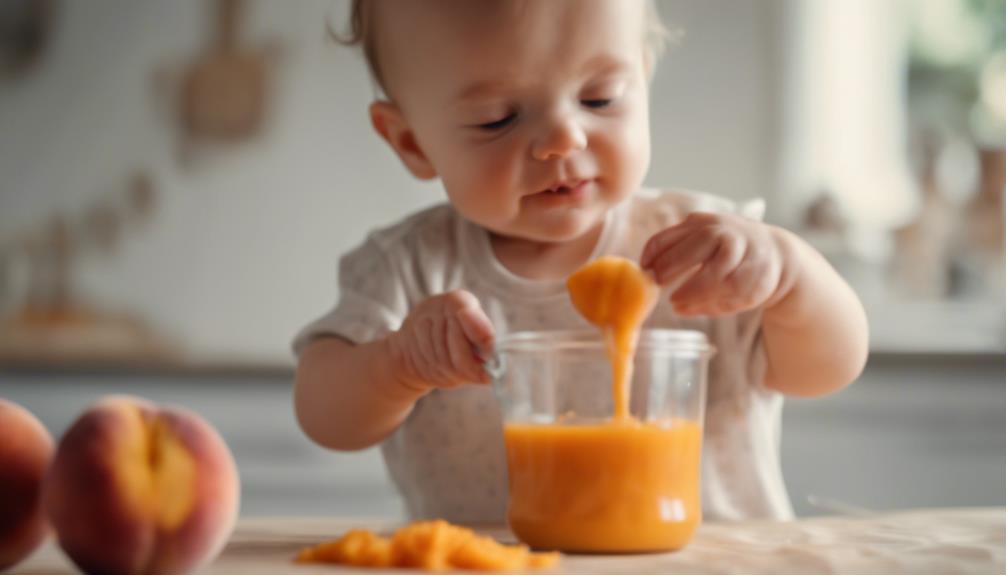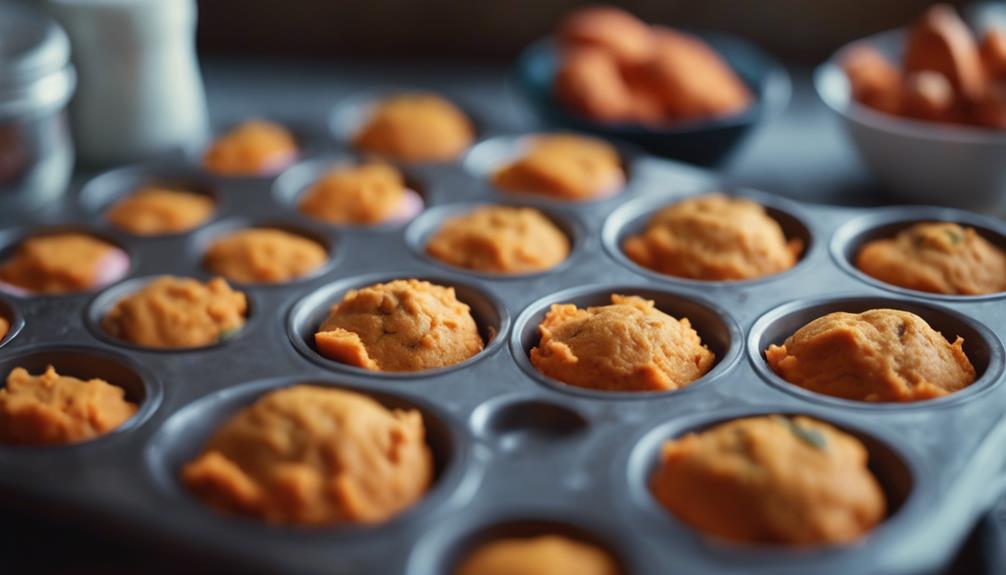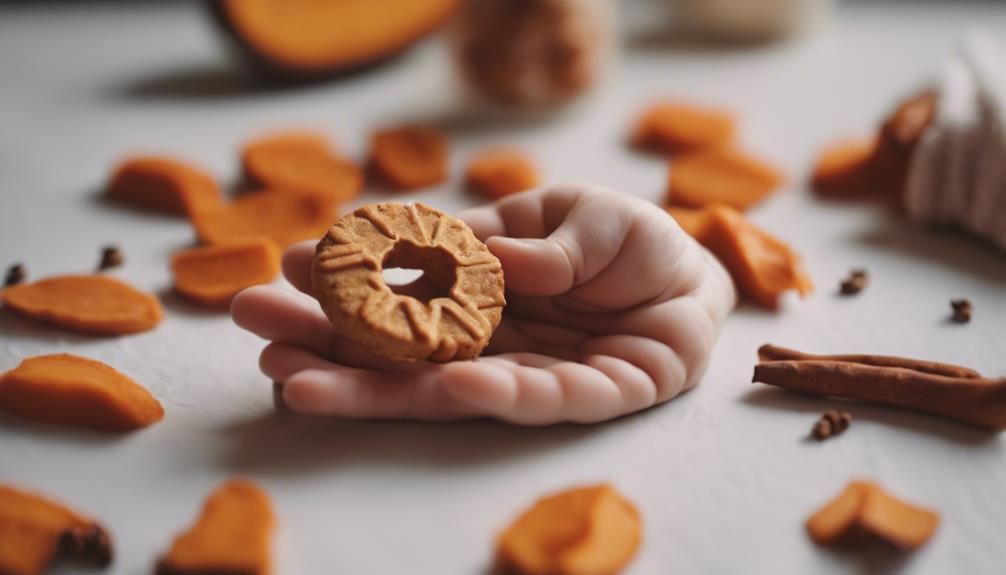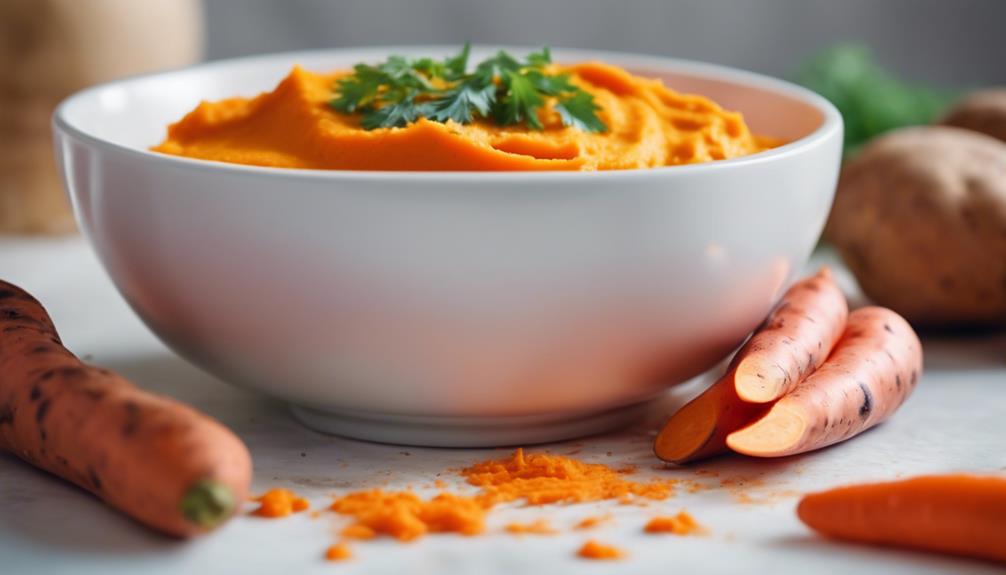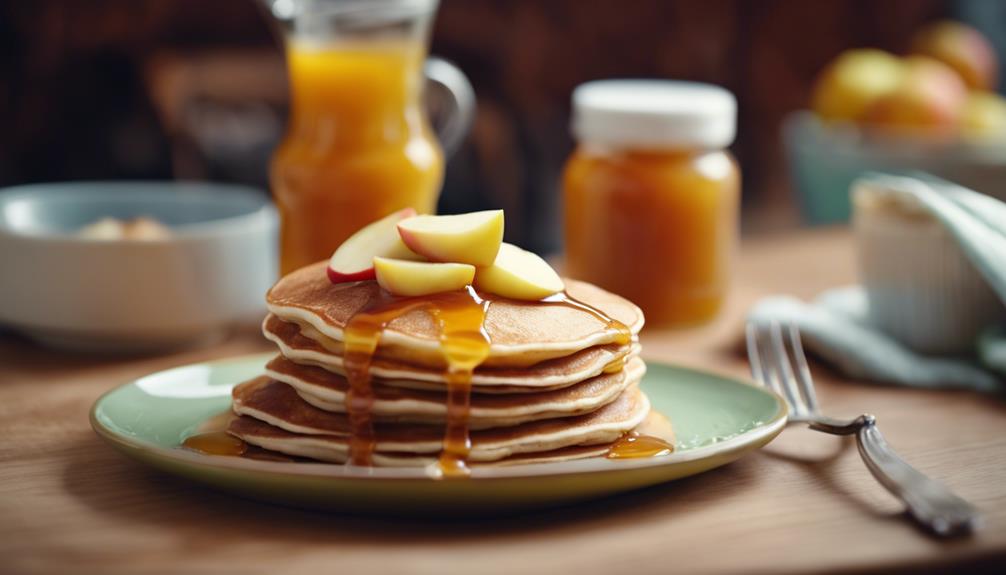For a delectable peach puree, begin by peeling and chopping ripe peaches, opting for fresh ones for best flavor. Blend the peaches until smooth, adding baby apple juice to sweeten. Thaw frozen peach puree overnight in the fridge or through a warm water bath. Portion the puree using silicone trays or jars, covering them during thawing. Serve in baby food recipes or standalone. Maintain freshness by thawing small amounts and properly storing leftovers labeled for up to 4 months. For further tips on using, choose fresh, firm peaches, and experiment with different combinations to keep your little one's meals exciting.
Key Takeaways
- Use ripe peaches for sweetness and nutrients.
- Blend with baby apple juice for a smooth consistency.
- Thaw frozen puree in the fridge or warm water bath.
- Portion in silicone trays or jars for convenient serving.
- Experiment with flavor combinations for variety.
Peach Puree Recipe Details
To make peach puree, begin by peeling and chopping ripe peaches. For this homemade baby food, opt for fresh peaches for the best taste and nutritional value. If fresh peaches aren't available, you can also use frozen peaches after defrosting them.
Once you have your peaches ready, place them in a blender to create a smooth puree consistency. It's recommended to add a splash of 100% baby apple juice for a touch of sweetness. When blending, make sure that the puree reaches a suitable texture for your baby by using a food mill, food processor, or blender.
After preparing the peach puree, store it in storage containers or ice cube trays for portioning. These containers make it easy to serve the peach puree to your baby in small, manageable amounts, ensuring freshness and convenience.
Choosing and Using Peaches

For the best peach puree, select fresh, firm peaches without bruising. Both white and yellow peaches are suitable for puree, with white peaches offering a sweeter taste. Opt for ripe peaches that yield slightly to pressure for enhanced flavor in the puree.
When using peaches with the skin on, make sure to wash them thoroughly to remove any dirt or pesticides. Peaches can also be blanched to easily peel off the skin, which can create a smoother texture in the puree.
Adjust the sweetness of the puree by adding honey or maple syrup for desserts, but avoid these additions if making baby food for purity. Experiment with different peach varieties to find the flavor profile that suits your taste preferences or your baby's palate.
Always aim for fresh, high-quality peaches when making homemade peach puree for the best results.
Thawing Frozen Peach Puree

When thawing frozen peach puree, it's recommended to utilize the fridge overnight or a warm water bath method for quicker defrosting.
Consider using silicone ice cube trays or freezer-safe jars for portioning and thawing small amounts efficiently.
Remember to cover the puree during thawing to maintain its freshness and prevent contamination, ensuring the quality and nutrients are preserved for your baby's meals.
Thawing Methods
Thawing frozen peach puree can be achieved by utilizing simple methods such as the fridge overnight or a warm water bath for quick defrosting.
When you need small amounts of peach puree for your baby's meal, consider thawing only what you require to maintain its flavor and texture effectively.
Freezing peach puree in silicone ice cube trays or freezer-safe jars allows for convenient portioning and storage, making meal prep in advance a breeze.
Properly thawed peach puree retains its nutritional value, ensuring your baby gets the best.
Once thawed, this versatile puree can be used in various baby food recipes or enjoyed on its own as a sweet treat.
Storage Recommendations
Consider utilizing silicone ice cube trays or freezer-safe jars for efficient storage of frozen peach puree for convenient portioning and easy access when needed.
Thawing frozen peach puree is a simple process that can be done in the fridge overnight or through a warm water bath.
To maintain the flavor and texture effectively, thaw small amounts of frozen peach puree at a time.
Properly labeled and dated, frozen peach puree can be stored in the freezer for up to 4 months, guaranteeing it remains safe for consumption.
Thawed peach puree is versatile and can be used in various baby food recipes or enjoyed as a standalone treat for babies and adults alike.
Serving Suggestions
To serve thawed peach puree efficiently, utilize silicone ice cube trays or freezer-safe jars for convenient portioning and easy access. Thaw frozen peach puree in the refrigerator overnight or expedite the process with a warm water bath.
Consider these serving suggestions for homemade peach puree:
- Use small portions: Thawing modest amounts at a time guarantees freshness and easy serving for your baby without compromising flavor or texture.
- Portioning for convenience: Silicone ice cube trays or freezer-safe jars are perfect for dividing the peach puree into manageable servings that can be effortlessly thawed as required.
- Thawing methods matter: Whether opting for a refrigerator overnight or a warm water bath for rapid thawing, select a method that fits your schedule to uphold the quality of the peach puree.
- Serve with care: Proper thawing techniques help maintain the nutrients and taste of the peach baby food, ensuring a delightful treat for your little one.
Nutritional Information and Equipment

The nutritional information for peach puree per 1/2 cup serving consists of:
- 38kcal
- 9g carbs
- 1g protein
- 186mg potassium
You'll need a blender or food processor to prepare this wholesome baby food.
The recipe falls under the Baby Food and Sauces/Condiments category, influenced by American cuisine.
Nutritional Content Overview
For a thorough understanding of the nutritional content and equipment necessary for preparing peach puree, explore the following details:
- Peach puree is a nutritious choice for baby food, offering around 38 calories, 9g of carbohydrates, 1g of protein, and 186mg of potassium in a 1/2 cup serving.
- It's an ideal homemade option for introducing first foods to infants, providing essential nutrients like Vitamin C for their growth and development.
- To create peach puree, a blender or food processor is essential to achieve a smooth texture and efficient blending of the fruit.
- This puree is low in sodium and fat, making it a healthy addition to baby food recipes and a flavorful way to introduce fruits while ensuring a balanced diet rich in Vitamin A and other nutrients.
Required Equipment Details
Equip yourself with a blender and food processor to prepare the essential tools for making peach puree baby food. These two pieces of equipment are vital for achieving the desired smooth texture and consistency in your peach puree.
The blender will help you break down the peaches into a fine puree, while the food processor will assist in further refining the mixture to guarantee a silky-smooth finish. By using both the blender and food processor in tandem, you can create a peach puree that's perfect for your little one's delicate palate.
Having the required equipment, the blender and food processor, on hand will make the process of preparing peach puree much more efficient and straightforward.
The blender will help you achieve a smooth and uniform texture, while the food processor will guarantee that the consistency is just right for your baby's consumption. With these tools at your disposal, you can easily whip up a nutritious and delicious peach puree for your little one to enjoy.
Cuisine and Course Focus
Explore the nutritional benefits and necessary equipment for preparing peach puree baby food.
When considering peaches for this puree, remember that they're packed with essential vitamins and minerals suitable for stage 1 baby diets.
During peach season, opt to use fresh fruits to maximize flavor and nutrients.
To prepare the puree, a blender or food processor is essential for achieving a smooth consistency that's easy for young infants to consume.
This homemade peach puree isn't just delicious but also Dairy-Free, making it suitable for babies with dietary restrictions.
At around six months of age, babies are typically ready to start trying out new foods, and peach puree can be a fantastic addition to their diet.
With its nutritional content, including 38kcal, 9g carbs, and 1g protein per 1/2 cup serving, peach puree offers a healthy and tasty treat for your little one.
Baby Food Preparation Tips

Consider using fresh, organic ingredients when preparing baby food at home to guarantee the best quality and nutrition for your little one. When making homemade Peach Baby food, ensure you select ripe, firm peaches without any bruising. Introduce peach puree as a first food to babies starting solids around 4-6 months of age. If fresh peaches are not available, you can use frozen peaches for convenience. Remember to store the homemade peach baby food in the fridge for 3-4 days or freeze it for longer preservation. When needed, thaw the frozen peach puree in the fridge or using a warm water bath before serving it to your little one. For variety, don't hesitate to experiment by combining peach puree with other foods like apples, carrots, sweet potatoes, or yogurt to create stage 2 baby foods.
| Baby Food Preparation Tips | ||
|---|---|---|
| 1. Use fresh, organic ingredients | 2. Introduce peach puree as a first food | 3. Store homemade peach baby food properly |
| 4. Thaw frozen peach puree before serving | 5. Experiment with different food combinations |
User Interaction and Feedback

Engage with a supportive community of parents and caregivers in the comments section as they share feedback and experiences related to making homemade baby food. Here are some insights into the user interactions and feedback you might encounter:
- Parents often express excitement about trying homemade baby food for the first time, with many sharing how their babies responded positively to fresh peach puree.
- Users frequently exchange tips and tricks for enhancing the flavor and texture of baby food, especially when using fresh peaches in the recipe.
- Discussions revolve around the process of starting solids and the benefits of making homemade baby food, highlighting a sense of community among caregivers.
- Feedback from users ranges from rating the recipe's simplicity to sharing personal experiences with their babies enjoying the peach puree, fostering a sense of encouragement and support within the community.
Frequently Asked Questions
What Goes Well With Peach for Babies?
For your little one, combine peaches with apples, pears, or bananas for tasty baby food. Enhance peach puree with sweet potatoes, carrots, or butternut squash for added nutrition. Try mixing in quinoa, oats, or rice for varied textures.
Can Babies Eat Pureed Peaches?
Yes, babies can consume pureed peaches. It's a suitable first food rich in Vitamin C, fiber, and antioxidants beneficial for growth. Introduce slowly, watch for allergies. Mix with fruits, veggies, or grains for a balanced diet. Homemade guarantees control over ingredients.
How to Prepare Peach for a 6 Month Old?
To prepare peaches for a 6-month-old, peel, pit, and chop the fruit. Cook in water until very soft, then strain or blend for a smooth puree. Remember to cool before serving to avoid burns.
How Can I Make My Baby Puree Taste Better?
To make your baby puree taste better, avoid adding sugar or honey. Enhance the flavor by mixing peach puree with apples or pears. Try adding a pinch of cinnamon or nutmeg. Experiment with textures by leaving in some pulp for older babies.
Conclusion
To sum up, peach puree baby food is a simple and nutritious treat for your little one. With the right ingredients and preparation techniques, you can easily create a sweet and healthy snack that your baby will love.
Remember to choose ripe peaches, follow proper thawing methods for frozen puree, and consider the nutritional benefits for your baby's development.
Share your experiences and feedback with other parents to continue improving your homemade baby food recipes.
